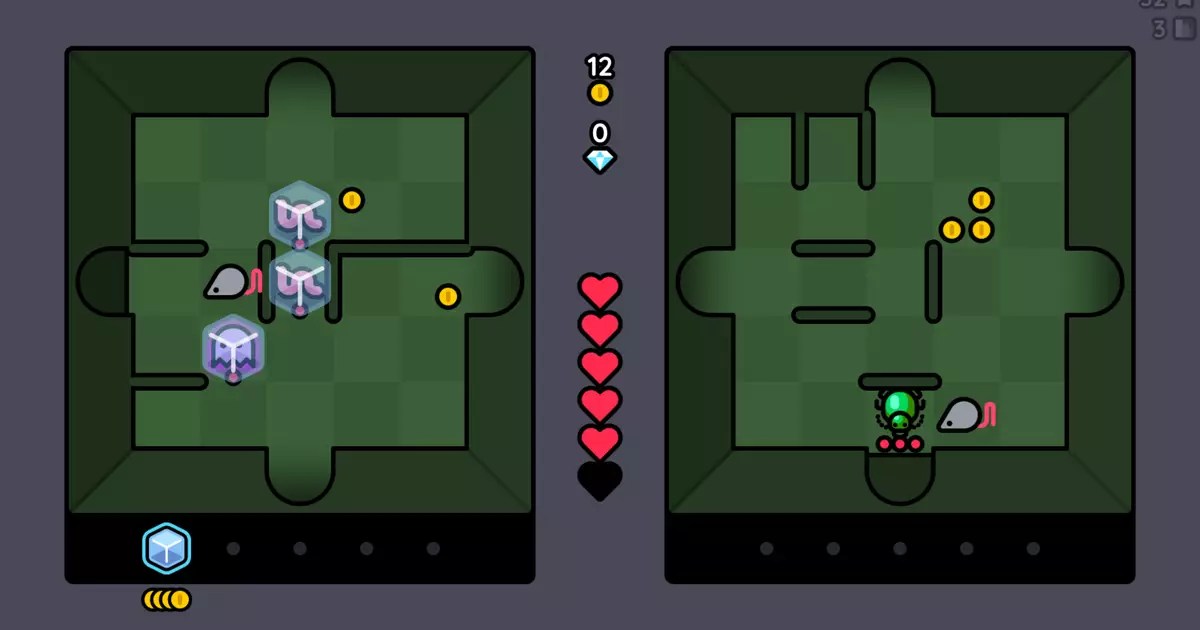At first glance, the concept of managing two characters simultaneously might evoke memories of frantic juggling or chaotic multitasking. However, Rat King transforms this potentially overwhelming mechanic into a captivating cerebral challenge. Instead of simply controlling a single avatar, players are entrusted with guiding two mice through separate, yet interconnected, dungeon corridors. This split-screen approach isn’t mere gimmickry; it elevates the gameplay into a complex ballet of planning, timing, and adaptive thinking. Each rat operates within its own 5×5 room, with enemies and obstacles that constantly shift and spawn anew. The players’ task is to orchestrate movements that maintain both rodents’ health while collecting coins, avoiding enemies, and progressing through each level.
This dual-control structure inherently demands a higher level of strategic forethought. Players must simultaneously analyze two distinct environments, understanding that synchronization isn’t always the optimal move. Often, leaving one rat in a vulnerable position temporarily or repositioning it to an ideal spot becomes the game’s central challenge. The mechanic subverts the traditional puzzle game’s focus on single-character navigation by encouraging players to think in terms of systems rather than isolated sequences.
Design Philosophy That Balances Frustration with Innovation
One of the most compelling aspects of Rat King is its meticulous attention to the game’s natural flow. It leverages subtle penalizations—notably the ghost enemy that awakens when players bounce repeatedly off walls—serving as both narrative flavor and gameplay deterrent. This element embodies a cleverly disguised lesson: brute-force or trial-and-error approaches are met with consequences designed to prompt reflection and smarter tactics.
This nuanced design reinforces a core philosophy: patience and precision triumph over impulsive movement. Items, such as freezing spells and directional control modifications, further deepen this strategic layer. For instance, using an ice cube to immobilize enemies temporarily provides crucial breathing space, whereas the swirly item alters your control inputs, forcing you to adapt quickly. These tools don’t just add variety; they compel players to develop a mental model of the environment and plan several steps ahead. Such layered mechanics elevate Rat King beyond simple puzzle-solving into an intricate dance of foresight, adaptability, and resource management.
Challenges and Rewards in Rewards-Based Strategy
A defining feature of Rat King is its reward system. Coins gained while exploring are spent in shops to purchase items that can turn the tide of a tough fight or streamline navigation. This introduces a risk-reward calculus—the more aggressive or exploratory players become, the more they risk losing progress—but also the more potential for powerful upgrades. This system encourages experimentation, pushing players to weigh their options carefully.
More importantly, the game’s layout fosters a sense of mastery over chaos. Successfully guiding a rat out of a dire corner or coordinating movements between two rooms provides that sweet sensation of control amid unpredictability. Moreover, the satisfying feeling that comes with figuring out the optimal sequence of moves reinforces the game’s respect for the player’s intelligence. Instead of hand-holding or overly generous hints, Rat King dares players to rely on their deduction skills, making each small victory feel genuinely earned.
A Personal Reflection: The Future of Indie Puzzle Design
What makes Rat King stand out is its deft blending of old-school challenge with fresh, innovative ideas. It demands patience, strategic thinking, and a willingness to embrace failure as part of the learning process. The game embodies a core truth: meaningful engagement arises from complexity that respects the player’s intelligence, not from superficial difficulty or excessive hand-holding.
Much like the classic “868-Hack” it references—and perhaps even beyond—Rat King exemplifies how indie developers can craft experiences that challenge conventions and push boundaries. It offers a glimpse into what puzzle games can become when layered with thoughtful design, meaningful choices, and a bit of mischievous spirit. As a player, I walk away not just with a sense of accomplishment but with a newfound appreciation for the art of strategic, well-crafted gameplay.


Leave a Reply